
ELA, History, and Math unit that links food production, eating choices, and health.
- Subject:
- English Language Arts
- Mathematics
- Social Science
- Material Type:
- Unit of Study
- Date Added:
- 03/28/2015


ELA, History, and Math unit that links food production, eating choices, and health.

This assignment ties thematically into texts concerning Mob Mentality, Cliques, and Groupthink. Students are asked to evaluate the psychology behind groupthink and relate it to written and world texts they have encountered.

FOCUS QUESTIONIs compassion the basis for morality?STUDENT OUTCOMESStudents will:examine and interpret the definitions of morality and compassion as presented in a variety of textsread, analyze, and discuss quotations and/or multimedia sourceswrite an original definition of a moral person (This definition will be used later in an argument paper which cites Atticus Finch's acts of compassion as evidence of his morality.) Image source: "Mockingbird" by skeeze on Pixabay.com.

During days 3-6 of the unit, students will complete a short, focused research assignment to learn about the characteristics of Sourthern Gothic Literature and to begin to view To Kill a Mockingbird through that lens. As is true with the rest of the unit, the three day time frame is a suggestion only and can be adjusted based on your schedule and the needs of the students.Image source: "Mockingbird" by skeeze on Pixabay.com.

Students will read and analyze a short story from the Southern Gothic genre entitled "The Life you Save May be Your Own" by Flannery O'Conner. They will continue to explore the ideas of human compassion and morality by examining the apparent lack of compassion in the characters of Mr. Shiftlet and the old woman, Lucynell Crater. Students will use close reading strategies to identify examples of indirect characterization that contribute to their analysis of these two central characters in the text. Image source: "Mockingbird" by skeeze on Pixabay.com.

This document is an example of an Affirmative case constructed for competitive Inter-collegiate debate within the National Parlimentary Debate Association. This example seeks to illuminate the way a policy-based case can be constructed by affirmative teams when presented with metaphors as debate topics.

Pairs of students respond to literature alternately in shared journals. Mini-lessons are presented on responding to prompts, creating dialogue, adding drawings, and asking and answering questions.
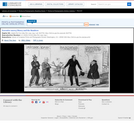
An attack on New York governor William L. Marcy's controversial decision to surrender Irish fugitives John Bamber, Sr., and his son James to the British consul after their detention in New York. The Bambers, wanted by the British government in connection with the killing of an Irish police constable, had sought asylum in the United States. Marcy's decision to return them to British custody caused a furor among New York Whigs and Irish immigrants. In the title the "A" in Marcy's name is crossed out and replaced with an "E." Marcy is shown leading the two Bambers by a rope tied to their necks toward a stout British consul on the right. The prisoners are in hand and leg irons. In the background a ship sits offshore and a heavyset man with spectacles, city recorder Richard Riker, runs up waving a writ of habeas corpus and crying "Stop! Stop!" On the left is the Hall of Justice; on the right the consul's office. Marcy's trousers are mended with a "50 cents" patch, a joke regarding a tailor's voucher for fifty cents that he submitted during his governorship of New York. Marcy: "Here my dear Sir are these savage Irishmen, whom I gladly deliver over to you, to be dealt with as the Queen's most excellent Majesty may think fit." British consul: "I thank your Excellency for your promptness, and shall represent your conduct in such a light to her most gracious Majesty, that I have not a bit of doubt she will reward you with a pair of new breeches!!" The younger Bamber: "Is this the boasted liberty of the soil? Is this the law for an adopted citizen?" Bamber, Sr.: "Is this the justice of the self-styled People's Party?"|Entered . . . 1838 by H.R. Robinson.|Printed & publd by H.R. Robinson, 52 Cortlandt St & 11-1/2 Wall St. N.Y.|Signed with monogram: C (Edward Williams Clay).|The print was registered for copyright on October 8, 1838.|Title appears as it is written on the item.|Weitenkampf, p. 55.|Forms part of: American cartoon print filing series (Library of Congress)|Published in: American political prints, 1766-1876 / Bernard F. Reilly. Boston : G.K. Hall, 1991, entry 1838-5.
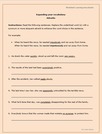
This Worksheet gives students practice on finding new words to express the same idea. It focuses on expanding the use of adverbs in English.

A ludicrous contrast of two influential Democrats, the obese Alabama Representative Dixon Hall Lewis and gaunt "Globe" editor Francis Preston Blair. The artist comments upon the unlikely alliance established in early 1840 between the Van Buren administration and certain Southern legislators in the circle of John Calhoun. Insinuation of Blair's corruption is also made. Lewis sits on a bench, holding his hat and walking stick before him. Blair embraces him with claw-like hands, saying, "I think Buchanan [i.e., Democratic senator from Pennsylvania James Buchanan] is making forcible illustrations of the bad effects of an inflated currency. Eh! my fat 'all y'?" Lewis responds, "Why I think, my "galvanized" friend that "you" & "I" illustrate best contraction and expansion! but d--n it Frank, it's strange you can't get fatter upon your Congressional corncrib & Treasury pap?" Blair was once called "a galvanized corpse" by South Carolina Congressman Francis W. Pickens. Two "Globe Reporters" in a gallery on the right remark, "I say Tom there is a hint in the way of geography--showing the comparative size of "Alabama" & the Globe." and "Yes! I think L--s appears quite resigned to the pressure of our lean governor's "specie claws!" "Expansion & Contraction" appears to be by the same hand as "Locofoco and Nulification Nuptials" (no. 1840-46).|Printed & published by H.R. Robinson, no. 52 Cortlandt St. N.Y. & Pennsa. Avenue Washington D.C.|Probably drawn by J. McGouldrick.|Title appears as it is written on the item.|Weitenkampf, p. 61.|Forms part of: American cartoon print filing series (Library of Congress)|Published in: American political prints, 1766-1876 / Bernard F. Reilly. Boston : G.K. Hall, 1991, entry 1840-47.
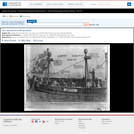
An anti-Jackson satire, critical of the President's federal treasury policy and of Vice-President Van Buren's influence on the administration's fiscal program. The print specifically attacks Jackson's plan to discontinue federal deposits in the Bank of the United States, and his "experiment" of placing them in selected state banks instead. The artist employs the image of a ship, a contemporary symbol of commerce, to forecast the ruination of American trade as a result of these measures. Jackson stands on a platform near the stern of the ship "Experiment," wielding a whip over eight crewmen who sit at spinning wheels. The ship is moored and upturned barrels sit on top of each of its three masts. A broom is tied to the foremost one, indicating that it is for sale. Rats scurry about the deck. Martin Van Buren stands behind Jackson near a padlocked door to the hold marked "Deposits" and "No Bank." A second ship burns in the distance. The various sailors comment: "Shiver my timbers Bob, if we ain't overrun with these blasted "Rats --" they eat up all our rations! I wish old Veto there, would drive 'em all overboard with little Martin at the head of them." "I say Jack I'm damn'd if this is like getting fifteen dollars a month is it?" "No, No, Shipmate, curse these spinning Jennies, its work only fit for lubbers and old women." "There is the old Constitution burning up! Her owners having no further occasion for her and cant afford to keep her in repair!" "Well what's the use of a Ship war? She's meant to protect "Commerce," but we've got none to protect!" Jackson: "No grumbling you lazy dogs! Perish commerce! perish trade! Andrew Jackson knows what's best for the Country, By the Eternal, Don't I Martin?" Van Buren: "To be sure you do if you mind what I tell you - Don't give up the ship General or I shall not succeed you!"|New York. Published by Anthony Imbert No 104 Broadway. |Title appears as it is written on the item.|Weitenkampf, p. 30.|Forms part of: American cartoon print filing series (Library of Congress)|Published in: American political prints, 1766-1876 / Bernard F. Reilly. Boston : G.K. Hall, 1991, entry 1833-8.
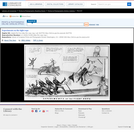
A figurative portrayal of Whig candidate Winfield Scott's failure in the 1852 presidential contest, attributed by the artist to his alliance with abolitionist interests. Scott is hoisted aloft via a pulley system by various influential supporters, including (left to right): an unidentified man, New York "Times" editor Henry J. Raymond, black abolitionist Frederick Douglass, Boston editor and abolitionist William Lloyd Garrison, Pennsylvania representative David Wilmot, and New York senator William Seward. They try to haul him up to the "President's Chair," which sits on a gallows-like structure, but the rope snaps owing to the "Free Soil" and "Abolition" weights chained to Scott's waist. Scott's supporters fall in unison to the left. Raymond: "You might have known them cussed weights would break the rope!" Seward:"Thus the noble Cesar fell, and you and I & all of us fell down and bloody Locofocoism flourished over us!" Scott (falling): "It may be the effect of my imagination, but it certainly feels as if something has given way!" At left, New York "Tribune" editor Horace Greeley rides a swaybacked horse carrying a "Tariff" bundle. He shouts to Scott, "Hold on General where you are just one minute till I come to help you!" Another man runs after Greeley crying, "Whoa! whoa! I say Greely don't ride that poor old nag to death!" Entering from the right-hand corner are a black man and his wife. The wife points at Scott and says, "Law! Mr. Cesar it seems to me dat de Gemman is gevine de wrong way."|Pubd. by John Childs, 84 Nassau St. N. York.|Signed with monogram: EWC (Edward Williams Clay).|Title appears as it is written on the item.|Davison, no. 205.|Weitenkampf, p. 108-109.|Forms part of: American cartoon print filing series (Library of Congress)|Published in: American political prints, 1766-1876 / Bernard F. Reilly. Boston : G.K. Hall, 1991, entry 1852-31.
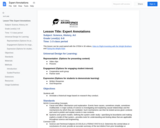
Students will annotate a historical image based on research they conduct.
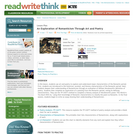
Students use art and poetry to explore and understand major characteristics of the Romantic period.
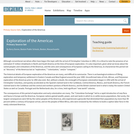
This collection uses primary sources to explore early exploration of the Americas. Digital Public Library of America Primary Source Sets are designed to help students develop their critical thinking skills and draw diverse material from libraries, archives, and museums across the United States. Each set includes an overview, ten to fifteen primary sources, links to related resources, and a teaching guide. These sets were created and reviewed by the teachers on the DPLA's Education Advisory Committee.

Students explore the nature and structure of expository texts that focusing on cause and effect and apply what they learned using graphic organizers and writing paragraphs to outline cause-and-effect relationships.
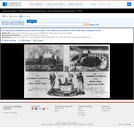
Entered according to Act of Congress, in the year 1838, by H.R. Robinson, in the Clerk's Office of the District Court of the United States of the Southern District of New York. Printed & published by H.R. Robinson, 52 Cortlandt Strt. New York.|Title appears as it is written on the item.|Forms part of: American cartoon print filing series (Library of Congress)

Students will explore the concepts of place value using their bodies as tools. They will time themselves performing various kinesthetic tasks like jumping jacks and sit ups and use the numbers that they record from these activities in their exploration. Working in groups, they will practice adding and subtracting and comparing numbers. They will also come up with creative ways to represent numbers using the properties of operation and the rules of place value.

Exploring Points of View in Literature Lesson Plan
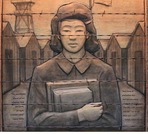
These short films by Stourwater Pictures are accompanied by activities for classroom and remote teaching and learning about the story of Japanese American WWII exclusion and incarceration on Bainbridge Island and Washington State.